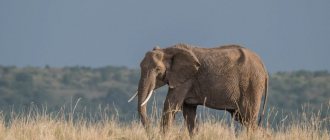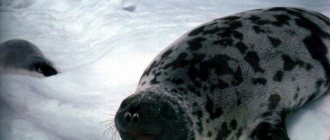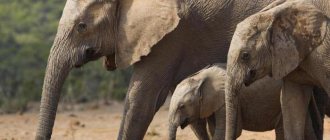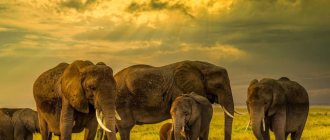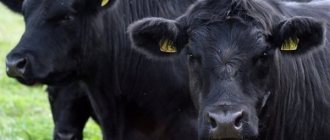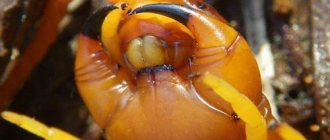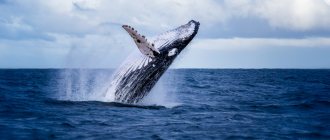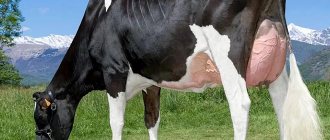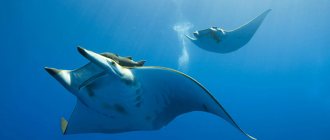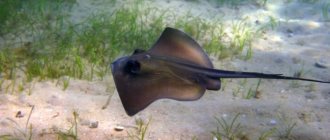Description and varieties
Sirens (Sirenia) are herbivorous mammals that live in water.
Their ancestral home is presumably Africa, and their closest relatives are proboscideans and hyraxes. Sirens are a small order of mammals, consisting of two families: dugongs (Dugongidae) and manatees (Trichechidae), combining 2 genera and a total of 4 species. Manatees are distinguished from dugongs primarily by their large, horizontal, spade-shaped dorsal fins, which rise and fall as they swim. At first glance, these massive animals resemble seals or whales, but in fact they are very distantly related to both groups - oddly enough, elephants are much closer to them. Sirens live only in water and never go onto land. Their forelimbs turned into flippers, their hind limbs almost atrophied and were not visible from the outside, and in their place a vertical caudal fin appeared. Unlike cetaceans, they feed mainly on plants.
A relative of the manatee - the sea cow, or Steller's cow (Hydrodamalis gigas) - lived only off the coast of the Commander Islands. It was discovered in 1741 by Bering's expedition and exterminated within 27 years. The body length of this animal reached 7.5 m, weight 3.5 tons. The front part of the body resembled a seal, the back part resembled a fish. The animal was called a cow because the females gave thick and fatty milk during pregnancy and after it, and the meat was as tasty as the best veal.
Notes
- Sokolov
V.E. Five-language dictionary of animal names. Mammals. Latin-Russian-English-German-French. - M.: Russian language, 1984. - P. 10. - 352 p. — 10,000 copies. - ↑ Husar, Sandra L. Trichechus inunguis. Mammalian Species, No. 72, pp. 1-4. Published June 15, 1977 by The American Society of Mammalogists.
- Mondolfi, E. Taxonomy, distribution and status of the manatee in Venezuela. Mem. Soc. Cienc. Nat. La Salle, 34(97):5-23; 1974
- ↑ Nowak, R. M. 1999. Walker's Mammals of the World. 6th Ed. The Johns Hopkins Univ. Press, Baltimore.
- Eisenberg & Redford. Mammals of the Neotropics, Vol. 3 - The Central Neotropics (Ecuador, Peru, Bolivia, Brazil). Univ. of Chicago Press, Chicago, IL, USA. 1999.
- Allen, GM Extinct and Vanishing Mammals of the Western Hemisphere (with the Marine Species of All the Oceans). American Committee for International Wildlife Protection. 1942.
- )
- .
Appearance
Sirens are very large and slow-moving mammals. They have a torpedo-shaped body without a cervical interception, with long, wide backs tapering to paddle-shaped, flattened tails. Their neck is mobile. The preserved front pair of five-fingered limbs was transformed into flippers. Manatees have vestigial nails, which are absent in dugongs. The forelimbs are mobile at the shoulder, elbow and wrist joints, which distinguishes sirenians from cetaceans. The fingers are covered with a common skin covering. The hind limbs are absent; during evolution, only rudiments of the pelvic girdle have been preserved. The tail is spoon-shaped in manatees and bilobed in dugongs. Sirens have a medium-sized head, with a relatively small mouth on the underside of the head; the nostrils are located at the end of the muzzle. In these animals, the well-developed upper lip forms a soft trunk-shaped “labial disc” equipped with vibrissae. Their eyes are small, with movable eyelids, without eyelashes, and the nictitating membrane is well developed. The skin of sirens is thick, folded, almost completely devoid of hair, with thick whiskers; subcutaneous fatty tissue is highly developed.
Book of Animals: Dugong
It is believed that the myth about the existence of mermaids was invented by southern sailors who, languishing from spermatotoxicosis, mistook dugongs for charming busty girls. We will leave aside the question of how much the eggs must be inflated to come to such a conclusion, and today we will talk about dugongs.
Dugongs are hefty aquatic mammals that, together with manatees, form the sirenian order. Incredibly calm gray carcasses hang lazily along the shores of the Indian Ocean countries, Indonesia and northern Australia. From the front, the big guy may remind you of your uncut little friend, but this conclusion will immediately disappear when you remember his size. The dugong is a five-meter long gray sausage with flippers and a tail. Their average weight reaches 500-600 kg.
Dugongs spend most of their lives in sunny, shallow waters. Here they eat algae with the help of their thick lips, similar to your girlfriend's bruh. In fact, feeding a dugong resembles the operation of a vacuum cleaner, which instead of cleaning, on the contrary, raises clouds of silt.
What is bruhlya? Of course I can guess, but I want to be sure.
Nutrition
The floating stems of river grass that manatees feed on contain silica, an abrasive defense against herbivores that causes rapid tooth wear. To counteract this factor, manatees have developed a unique adaptation that minimizes the effect of abrasion: throughout their lives, the old teeth located in the front fall out, and the back teeth take their place. The front part of the palate and lower jaw, as well as the upper part of the small tongue, are covered with horny plates used for grinding food.
The stomach of sirens is not divided into chambers or sections. Their intestines are extremely long - more than 45 m in manatees. Between the small and large intestines there is a large cecum with paired blind-ending pouches. Bacterial digestion of cellulose occurs in this rear part of the digestive tract and allows sirenians to process large volumes of relatively low-quality food.
Sirens feed mainly on marine plants and algae. Manatees eat a variety of plant matter, including mangrove leaves, hydrilla, leaves and acorns from overhanging branches, and even floating palm fruit. Dugongs are more selective in their diet and feed on sea grass (Zostera) - marine flowering plants. Sirens also ingest small invertebrates found on plants; and while the protein content of invertebrates is ultimately beneficial, their consumption is likely unintentional. Every day, sirens spend up to 8 hours feeding and eat a volume of food equivalent to 5-10% of their body weight.
Preservation
The IUCN Red List ranks the Amazonian manatee as vulnerable. Population declines are primarily the result of hunting, but also calf mortality, climate change and habitat loss. However, their dark aquatic habitat makes it difficult to obtain accurate population estimates.
There are no national management plans for the Amazonian Manatee, other than Colombia. INPA currently cares for 34 manatees in captivity and CPPMA cares for 31 manatees. The manatee has been protected by Peruvian law since 1973, through Supreme Decree 934-73-AG, prohibiting hunting and commercial exploitation of the manatee.
Hunting remains the biggest problem and continues across much of its range, even within reserves. In 1986 it was believed that hunting levels in Ecuador were unstable and would be gone from that country within 10–15 years. While hunting is still taking place, an increasing risk to its long-term survival in Ecuador is now believed to be the risk of oil spills. Oil exploration also means increased traffic on the rivers.
Peru's Amazonian manatees have experienced much of their decline due to hunting by the human population for meat, crying, skin and other materials that can be collected from the manatee. Such hunting is performed with harpoons, gillnets, and set traps. Much of this hunting occurs in lakes and streams near the Pacaya-Samiria National Reserve in northeastern Peru. The species is slow, docile, and is often found feeding on the surface of the lakes and rivers it inhabits. Manatees are also at risk from pollution, accidental drowning in commercial fishing nets, and deterioration of vegetation by soil erosion resulting from deforestation. Moreover, the indiscriminate release of mercury from mining activities threatens the entire aquatic ecosystem of the Amazon Basin.
Reproduction and social behavior
Sirens are polygamous. When the female is ready to breed, herds of males follow her. Sometimes they show aggression towards each other. Mating occurs belly to belly, which may require diving to greater depths. Pregnancy lasts from 12 to 14 months. Before giving birth, females swim to shallow water; sometimes this results in them being washed ashore and forced to wait for the tide to return to the water. All sirenians are capable of breeding all year round, but each species has seasonal peaks when birth rates are particularly high. As a rule, one calf is born, occasionally, in 1.8% of cases, two. The newborn needs to reach the surface of the water and take his first breath; He swims independently already on the first day of life. Reproduction occurs every 2.5-7 years; a female who has lost her offspring is able to reproduce more often if she loses her young calf. Puberty occurs at the age of 3-10 years. The average lifespan of sirens ranges from 50 to 70 years, with a maximum estimated at approximately 73 years.
Strong social bonds in modern sirens are formed only between mother and calf. Calves are born with teeth and are able to eat plant foods no later than a week after birth. Breastfeeding lasts 12-18 months, sometimes up to four years. Long-term lactation is probably intended so that the mother can teach the cub the necessary migration routes and acquaint her with food items and feeding areas. Very young calves synchronize their activities, such as breathing and resting, according to their mother. If the female feels that the calf is in danger, she may confront the predator and even headbutt her, although more often she prefers to swim away with the calf. Historically, dugongs gathered in huge herds of several hundred individuals. Modern herds are much smaller in size and form less frequently. It is believed that such associations help calves learn to swim in a protected environment. There is evidence that male Steller's cows took part in protecting their young and even attacked boats to protect their offspring.
Where does the manatee live?
Photo: Sea Manatee
The manatee's habitat is the western coast of the African continent, along almost the entire coast of the United States. Most often, animals live in small and not too deep bodies of water. They prefer to choose those reservoirs where there is a sufficient amount of food supply. These can be rivers, lakes, small bays, lagoons. In some cases, they can be found in coastal zones of larger and deeper bodies of water at a depth of no more than three and a half meters.
Manatees can live freely in both fresh and sea water. All sea cows, regardless of species, prefer warm water, the temperature of which is at least 18 degrees. It is uncharacteristic for animals to move and migrate frequently and over long distances. They rarely travel more than 3-4 kilometers per day.
Animals prefer to sway in shallow water, occasionally rising to the surface to take air into their lungs.
Animals are very sensitive to low water temperatures. If the temperature drops to less than + 6 - +8 degrees, this can cause the death of animals. In this regard, with the onset of winter and colder temperatures, animals move away from the shores of America to South Florida. Animals often accumulate in the region where thermal power plants are located. When the warm season arrives again, the animals return to their natural habitat.
